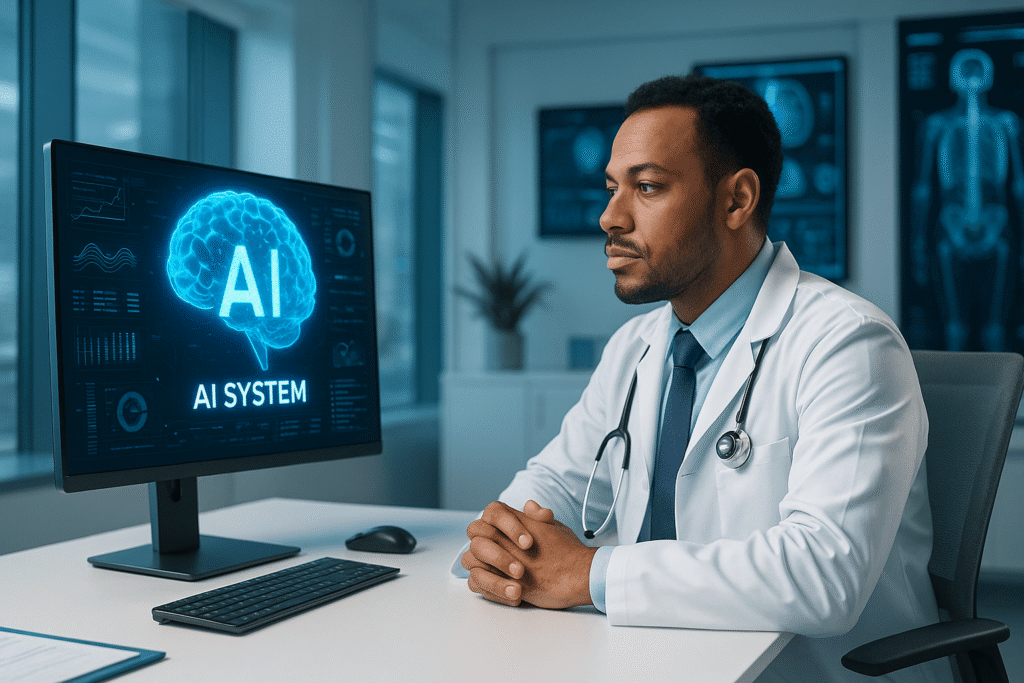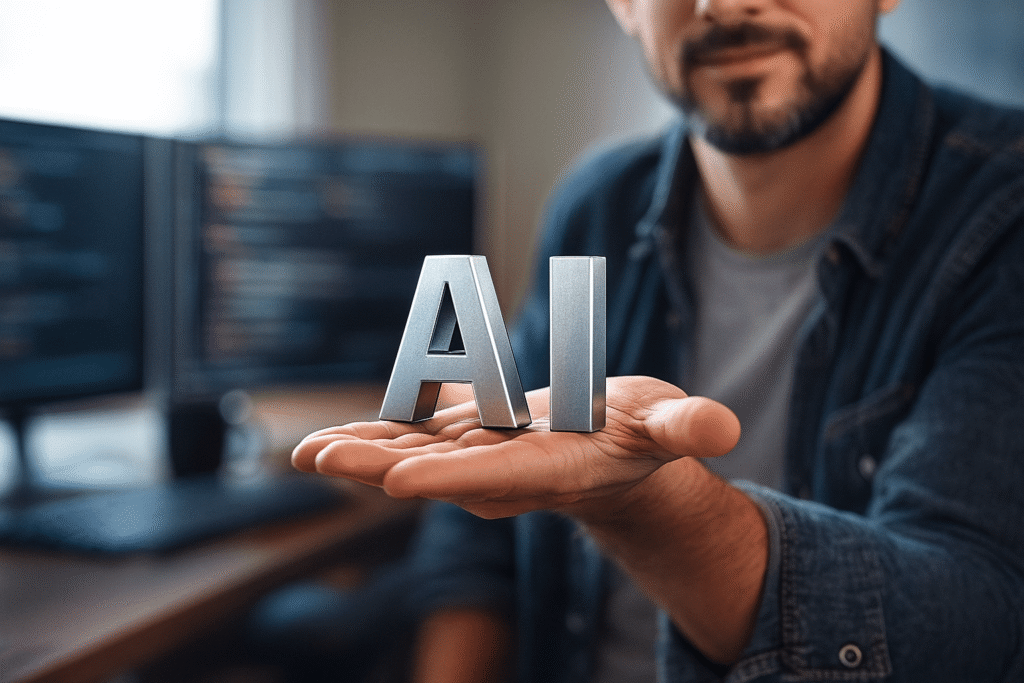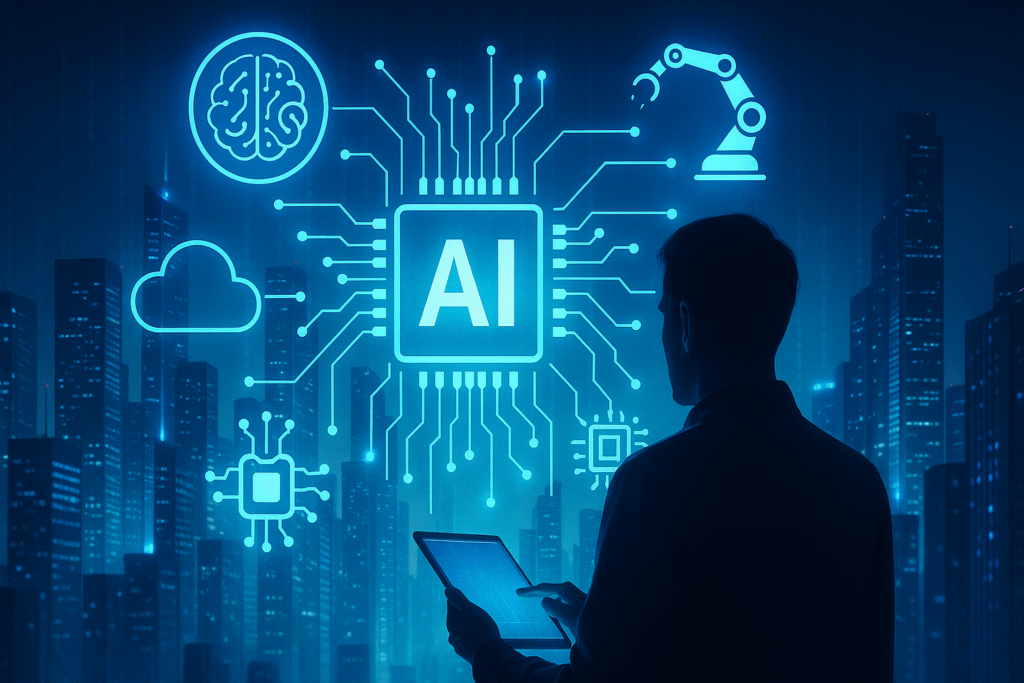AI Integration in Healthcare

Artificial intelligence is already reshaping how healthcare is delivered, from diagnosing diseases earlier to making treatments more personalized and efficient. Hospitals, research labs, and health tech companies are increasingly turning to AI to handle tasks that range from analyzing medical images with near-human accuracy to predicting patient outcomes and even discovering new drugs. The global AI in healthcare market is projected to grow to $187 billion by 2030, underscoring the urgency and scale of this transformation.
Yet, while the promise of AI is undeniable, its integration into healthcare is not without challenges. Questions around patient privacy, algorithmic bias, regulatory oversight, and physician trust remain front and center. As the World Health Organization emphasizes, AI in healthcare must balance innovation with ethics, ensuring that technology enhances, not replaces, the human element of care.
This article explores where AI is already making an impact in healthcare, the benefits it brings, the challenges that must be addressed, and what the future may hold for an AI-driven healthcare ecosystem.
Table of Content
Current Applications of Artificial Intelligence in Healthcare
Artificial intelligence is no longer confined to research labs — it’s already integrated in delivering care in hospitals, clinics, and even at home. Here are the main AI application cases in this industry.
AI in Diagnostics
Diagnostic accuracy is one of the most impactful areas where AI is proving its value. By processing vast datasets of medical images, AI systems can detect subtle patterns that may be invisible to the human eye.
- In radiology, Google’s DeepMind developed an algorithm that outperformed human radiologists in detecting breast cancer from mammograms, reducing false positives by 5.7% and false negatives by 9.4%.
- In dermatology, Stanford researchers trained an AI system to classify skin cancer with accuracy comparable to board-certified dermatologists.
- AI is also being used in ophthalmology to detect diabetic retinopathy and glaucoma earlier than traditional screenings.
These breakthroughs not only speed up diagnoses but also expand access in regions with shortages of specialists.
AI in Treatment Planning and Drug Discovery
AI supports personalized medicine by tailoring treatments to each patient’s unique profile. Machine learning models analyze data from genetic sequencing, lab results, and electronic health records to recommend optimal therapies.
- IBM’s Watson for Oncology, though not without challenges, pioneered the concept of using AI to provide evidence-based treatment recommendations.
- In drug discovery, AI dramatically shortens timelines. For example, the British startup BenevolentAI identified a potential COVID-19 treatment in just four days using AI-driven drug repurposing.
- AI also accelerates clinical trials by identifying suitable candidates, predicting dropout rates, and analyzing vast volumes of biomedical literature.
This application is particularly critical as the average cost of bringing a drug to market exceeds $2.6 billion and takes more than a decade.
AI in Administrative and Operational Efficiency
A large share of healthcare costs comes from administration rather than direct patient care. AI is streamlining these workflows, freeing up clinicians to focus more on patients.
- AI-enabled tools automate medical coding, billing, and claims processing, reducing errors and administrative costs.
- Predictive analytics models help hospitals anticipate patient admissions, allocate staff, and manage supply chains more effectively.
- For example, Johns Hopkins Hospital uses AI to manage patient flow, predicting demand and optimizing bed utilization, which reduced emergency department overcrowding.
This “invisible AI” often goes unnoticed by patients but plays a massive role in improving efficiency and lowering costs.
AI in Patient Engagement and Monitoring
The patient experience is also being reshaped by AI. Intelligent virtual assistants, chatbots, and wearables are empowering patients to take a more active role in their own health.
- AI chatbots like Woebot provide mental health support, offering cognitive behavioral therapy-based conversations to users experiencing stress or depression.
- Wearables combined with AI algorithms can detect irregular heart rhythms, such as atrial fibrillation, before they cause serious complications. Apple’s Heart Study demonstrated how wearable devices can be used at scale to identify undiagnosed heart issues.
- Remote patient monitoring platforms powered by AI analyze continuous streams of data from connected devices, alerting providers when intervention is needed. The FDA is actively developing frameworks to regulate these AI/ML-enabled medical devices.
This proactive, continuous care reduces hospital readmissions and improves outcomes for patients with chronic diseases.
Takeaway
While AI doesn’t replace doctors, it amplifies their capabilities, making healthcare more accurate, personalized, and efficient. The key challenge is integrating these tools into existing workflows without compromising trust, transparency, or patient safety.
Benefits of AI Integration
While the applications of AI are already visible in diagnostics, treatment planning, and patient engagement, the broader benefits emerge when these tools are integrated across the entire healthcare ecosystem. The true promise of AI lies not only in doing things faster but in reshaping how care is delivered, accessed, and sustained.
Improved Population Health and Preventive Care
Integration of AI allows healthcare systems to move from treating illness to preventing it at scale.
Predictive models can identify at-risk groups before disease develops, enabling targeted interventions that improve population health outcomes. For example, AI-powered screening programs can forecast chronic conditions like diabetes or cardiovascular disease years earlier, which translates into fewer hospitalizations and lower long-term costs.
This shift from “sick care” to “health care” is one of the most profound benefits of AI.
Reducing Health Disparities Through Access Expansion
AI has the potential to act as a force equalizer in global health.
In regions with few specialists, AI-driven diagnostic platforms (delivered via cloud and mobile) can give patients access to expertise that would otherwise be unavailable. For rural hospitals or low-resource countries, AI-enabled telemedicine can close care gaps, providing more consistent quality of care.
However, this benefit is conditional on responsible data use; diverse, representative datasets are required to prevent AI technologies from reinforcing existing inequalities.
Economic Sustainability for Healthcare Systems
Healthcare spending is growing unsustainably, especially in aging populations. AI helps bend the cost curve by:
- optimizing hospital resource utilization (staffing, equipment, beds);
- reducing unnecessary testing and procedures through smarter triage;
- preventing complications that drive up costs in chronic care.
Strengthened Clinician Performance and Wellbeing
Physician burnout is at crisis levels, with nearly 63% of U.S. physicians reporting symptoms in 2021. AI helps alleviate this by:
- automating routine, time-consuming tasks;
- surfacing critical insights quickly, improving decision confidence;
- allowing clinicians to spend more time in direct patient care — the part of medicine that restores purpose and reduces burnout.
Rather than replacing doctors, AI can be seen as a wellness intervention for the workforce itself, improving retention and job satisfaction.
Accelerated Pace of Medical Discovery
AI integration goes beyond optimizing existing workflows; it fundamentally accelerates the innovation cycle in medicine.
Algorithms can mine millions of research papers, clinical trial datasets, and molecular structures in days — a task impossible for human researchers. This creates faster pathways to vaccines, precision therapies, and new treatments for rare diseases. In the long term, AI-driven simulations (like digital twins of patients) could allow researchers to “test” treatments virtually before clinical trials, reducing risks and costs.
Building a Patient-Centric, Data-Driven Culture
Perhaps the most transformative benefit is cultural. AI integration signals a shift toward patient-centered healthcare, where decisions are based on continuous, real-time data rather than episodic doctor visits. Patients become active participants in their health journey, supported by AI tools that personalize advice, monitor progress, and encourage adherence. This creates a loop where patients, clinicians, and systems are constantly learning and adapting together — a hallmark of a next-generation healthcare model.
Ethical, Legal, and Technical Challenges
The integration of artificial intelligence into healthcare is not just a technical challenge — it is also a deeply ethical and legal one. While AI holds immense promise, its widespread adoption brings questions about safety, accountability, fairness, and trust. Ignoring these challenges could undermine public confidence and stall innovation.
Data Privacy and Security
AI requires enormous amounts of data to function effectively, but the very scale of this requirement creates risks. Medical records, genomic data, and even data from wearable devices must be safeguarded against misuse.
Healthcare is already one of the most targeted sectors for cyberattacks, with 707 reported data breaches in the U.S. alone in 2022, affecting over 51 million records. Regulations like HIPAA in the U.S. and GDPR in the EU impose strict rules on data usage, but compliance becomes murky when data is transferred across borders for AI training. There is also the issue of “secondary use” of data. Patients may consent to treatment but not realize their anonymized data is being used to train commercial algorithms.
👉 Ethical Question: How do we strike a balance between protecting patient privacy and fueling medical innovation that relies on big data?
Bias and Fairness in AI Models
Bias in AI is one of the most pressing risks in healthcare integration. If datasets lack diversity, the models will fail to serve underrepresented populations.
A widely used healthcare risk algorithm in the U.S. underestimated the needs of Black patients, affecting care prioritization for over 200 million people. Also, facial recognition-based diagnostic tools have shown reduced accuracy for patients with darker skin tones due to biased training datasets. Gender bias is also a concern: women are historically underrepresented in clinical trials, leading to less accurate AI-driven insights for female patients.
👉 Ethical Question: Who is responsible for ensuring datasets reflect true population diversity — developers, regulators, or healthcare providers?
Regulatory and Legal Frameworks
AI in healthcare often evolves faster than the laws that govern it. While progress is being made, regulatory systems are still catching up.
Liability remains unresolved. If an AI tool misdiagnoses a patient, does responsibility fall on the doctor (for trusting it), the hospital (for deploying it), or the software developer?
👉 Legal Question: How can we assign accountability when human and machine decisions are intertwined?
Physician and Patient Trust
Even if AI systems are accurate, they won’t be adopted unless clinicians and patients trust them.
Many AI models are “black boxes” — they can make accurate predictions but cannot explain how they arrived at them. This lack of transparency undermines physician confidence. Patients may also resist AI-driven care if they feel it reduces the “human touch.” A survey by the Pew Research Center found that 60% of Americans would feel uncomfortable if their healthcare provider relied heavily on AI. To build trust, experts advocate for explainable AI (XAI), which allows clinicians to understand and validate model outputs.
👉 Cultural Question: Can healthcare preserve its human core while embracing machine-driven insights?
Technical Limitations and Integration Challenges
Even the most advanced AI systems face barriers when moving from lab to clinic.
- Interoperability issues: AI tools often don’t integrate smoothly with existing electronic health record (EHR) systems.
- Generalizability problems: Models trained in one hospital may perform poorly in another due to differences in data collection practices.
- Maintenance requirements: AI algorithms need continuous retraining as medical knowledge evolves — otherwise, they risk becoming outdated or unsafe.
A well-known example is IBM Watson for Oncology, which faced criticism after its recommendations were found to be inconsistent or unsafe in some cases. Despite enormous investment, the project highlighted the difficulty of scaling AI safely into real-world care.
Future Outlook: AI-Driven Healthcare Ecosystem
The next decade will see artificial intelligence move from experimental pilots to becoming a core pillar of healthcare. Instead of being limited to isolated tools, AI will increasingly underpin an ecosystem of connected, data-driven, and patient-centered solutions.
Predictive and Preventive Healthcare
AI’s greatest potential lies in shifting healthcare from reactive treatment to proactive prevention.
Predictive models can forecast the likelihood of chronic illnesses like diabetes or cardiovascular disease years before symptoms emerge. For example, researchers at the Mayo Clinic are using AI-enhanced ECGs to detect early signs of left ventricular dysfunction, a precursor to heart failure, with promising accuracy.
As these models mature, they could help clinicians design lifestyle or medication interventions that prevent costly hospitalizations.
AI in Genomics and Precision Medicine
Advances in genomics combined with AI will enable truly personalized treatments.
AI can rapidly analyze entire genomes to identify risk factors and suggest targeted therapies. Precision oncology is already benefiting: companies like Tempus and Foundation Medicine are using AI to match cancer patients with therapies based on tumor-specific genetic mutations. The National Institutes of Health (NIH) is investing heavily in AI-driven biomedical research, including large-scale genomics projects.
Generative AI in Clinical Practice
Generative AI will play a major role in reducing clinician workload. Tools like large language models can draft patient notes, summarize lab results, and even generate clinical trial protocols. Clinicians using AI-assisted documentation can spend less time on electronic health record (EHR) tasks, focus more on patient care, and reduce burnout chances.
However, oversight will be critical: generative models must be validated to avoid hallucinations or unsafe recommendations.
Seamless Human-AI Collaboration
The future will not be about replacing doctors but augmenting their decision-making. Radiologists, pathologists, and primary care physicians will increasingly work alongside AI systems that highlight anomalies, suggest treatment options, or flag risks. A World Economic Forum–supported vision suggests that by the near future, human‑AI‑system collaboration, where clinicians, intelligent systems, and institutional infrastructure work together, will be central to delivering equitable and efficient healthcare.
Global and Equitable Access to AI Tools
The democratization of AI in healthcare could help reduce disparities, but only if deployment is equitable. Cloud-based AI platforms can bring advanced diagnostics to rural or underserved areas where specialists are scarce.
However, the World Health Organization warns that unequal access to AI could widen the gap between wealthy and low-resource health systems if not carefully managed. Future policies must ensure that innovation benefits all populations, not just those in wealthy nations.
Conclusion: Balancing Innovation and Responsibility
Artificial intelligence has already proven its ability to improve diagnostics, accelerate drug discovery, streamline hospital operations, and empower patients with more personalized care. Yet as transformative as these technologies are, their full potential will only be realized if healthcare leaders integrate them with caution, transparency, and accountability.
The challenge is not simply to innovate but to innovate responsibly. AI systems must be designed with diverse datasets to avoid bias, regulated with clear legal frameworks to assign accountability, and deployed with explainability so that both clinicians and patients trust the outcomes. At the same time, strong safeguards around privacy and security are essential to protect sensitive health data.
The future of healthcare sector will not be machines replacing humans, but humans and AI working side by side. Physicians will bring empathy, context, and judgment, while AI will provide precision, speed, and predictive insights. This synergy can lead to a healthcare ecosystem that is smarter, safer, and more equitable.
As the World Health Organization reminds us, the promise of AI in healthcare must always be weighed against the responsibility to protect human dignity and rights. If that balance is achieved, AI has a chance to redefine healthcare for generations to come.
FAQ
No. AI is designed to augment, not replace, healthcare professionals. While algorithms can process large datasets, identify patterns, and even suggest treatment options, they cannot provide the empathy, context, and holistic judgment that human clinicians offer. The future will focus on human-AI collaboration, where AI supports doctors in decision-making but final responsibility remains with the physician.
AI improves patient care by:
- Enhancing diagnostic accuracy, e.g., detecting diseases earlier through advanced imaging analysis
- Enabling personalized medicine, tailoring treatments to an individual’s genetics and lifestyle.
- Supporting preventive care, predicting chronic diseases before they fully develop.
- Improving patient engagement, with AI-powered chatbots and wearables providing 24/7 monitoring and support.
The main risks include:
- Bias in algorithms which can lead to unequal treatment across demographic groups
- Data privacy concerns, since healthcare data is highly sensitive and a frequent target of cyberattacks.
- Lack of explainability makes it hard for clinicians and patients to trust AI-generated decisions.
- Regulatory uncertainty, as laws struggle to keep pace with fast-moving innovations.
Sources
- Grand View Research – AI in Healthcare Market Size Report
https://www.grandviewresearch.com/industry-analysis/artificial-intelligence-ai-healthcare-market - Nature – Dermatologist-level Classification of Skin Cancer with Deep Neural Networks
https://www.nature.com/articles/nature21056 - Science – International Evaluation of an AI System for Breast Cancer Screening
https://www.science.org/doi/10.1126/science.aax2342 - Cell Reports Medicine – Artificial Intelligence for Drug Discovery and Biomarker Development
https://www.sciencedirect.com/science/article/pii/S2589750020301928 - Advisory Board – IBM’s Watson for Oncology Faltered—Here’s Why
https://www.advisory.com/daily-briefing/2018/07/27/ibm - NIH / PubMed – The AI Revolution in Drug Discovery
https://pmc.ncbi.nlm.nih.gov/articles/PMC7105853/ - ResearchGate – AI Apps for Screening & Diagnosing Diabetic Retinopathy
https://www.researchgate.net/publication/394311461_Artificial_intelligence-based_apps_for_screening_and_diagnosing_diabetic_retinopathy_and_common_ocular_disorders - Johns Hopkins Medicine – AI Tool to Assist with Emergency Department Triage
https://www.hopkinsmedicine.org/news/articles/2022/11/tool-developed-to-assist-with-triage-in-the-emergency-department - Woebot Health – Official Website
https://woebothealth.com/ - New England Journal of Medicine – Apple Heart Study: Smartwatch-based Arrhythmia Detection
https://www.nejm.org/doi/full/10.1056/NEJMoa1901183 - NIH / PubMed – AI in Medical Imaging: Opportunities and Challenges
https://pmc.ncbi.nlm.nih.gov/articles/PMC10773242/ - ResearchGate – Real-Time Predictive Health Monitoring Using AI-Driven Wearables https://www.researchgate.net/publication/387577136_Real-Time_Predictive_Health_Monitoring_Using_AI-Driven_Wearable_Sensors_Enhancing_Early_Detection_and_Personalized_Interventions_in_Chronic_Disease_Management
- HIPAA Journal – 2022 Healthcare Data Breach Report
https://www.hipaajournal.com/2022-healthcare-data-breach-report - Labiotech – Why Women Are Still Underrepresented in Clinical Trials
https://www.labiotech.eu/in-depth/women-clinical-trial/ - U.S. FDA – AI and Machine Learning in Software as a Medical Device
https://www.fda.gov/medical-devices/software-medical-device-samd/artificial-intelligence-software-medical-device - European Union – Artificial Intelligence Act (Proposed Regulation)
https://artificialintelligenceact.eu/ - Pew Research Center – Public Attitudes Toward AI in Healthcare
https://www.pewresearch.org/science/2023/02/22/60-of-americans-would-be-uncomfortable-with-provider-relying-on-ai-in-their-own-health-care/ - IBM – Explainable AI
https://www.ibm.com/think/topics/explainable-ai - NIH / PubMed – AI and Cardiovascular Health
https://pmc.ncbi.nlm.nih.gov/articles/PMC11878133/ - Mayo Clinic – AI-Enabled ECGs in Pediatric Cardiac Care
https://www.mayoclinic.org/medical-professionals/pediatrics/news/revolutionizing-pediatric-cardiac-care-through-ai-enabled-ecgs/mac-20586669 - Tempus – Official Website
https://www.tempus.com/ - Foundation Medicine – Official Website
https://www.foundationmedicine.com/ - National Institutes of Health – Artificial Intelligence Research
https://datascience.nih.gov/artificial-intelligence - Nature Medicine – High-Performance Medicine: Human + AI
https://www.nature.com/articles/s41586-019-1799-6 - World Economic Forum – Human-AI Collaboration in Healthcare
https://www.weforum.org/stories/2024/04/human-ai-system-collaboration-equitable-healthcare/?utm_source=chatgpt.com - World Health Organization – Ethics and Governance of AI for Health
https://www.who.int/publications/i/item/9789240029200 - ScienceDirect – Drug Discovery Costs and Timelines
https://www.sciencedirect.com/science/article/abs/pii/S1359644615003906
TurnKey Staffing provides information for general guidance only and does not offer legal, tax, or accounting advice. We encourage you to consult with professional advisors before making any decision or taking any action that may affect your business or legal rights.
Tailor made solutions built around your needs
Get handpicked, hyper talented developers that are always a perfect fit.
Let’s talkPlease rate this article to help our team improve our content.
Here are recent articles about other exciting tech topics!




